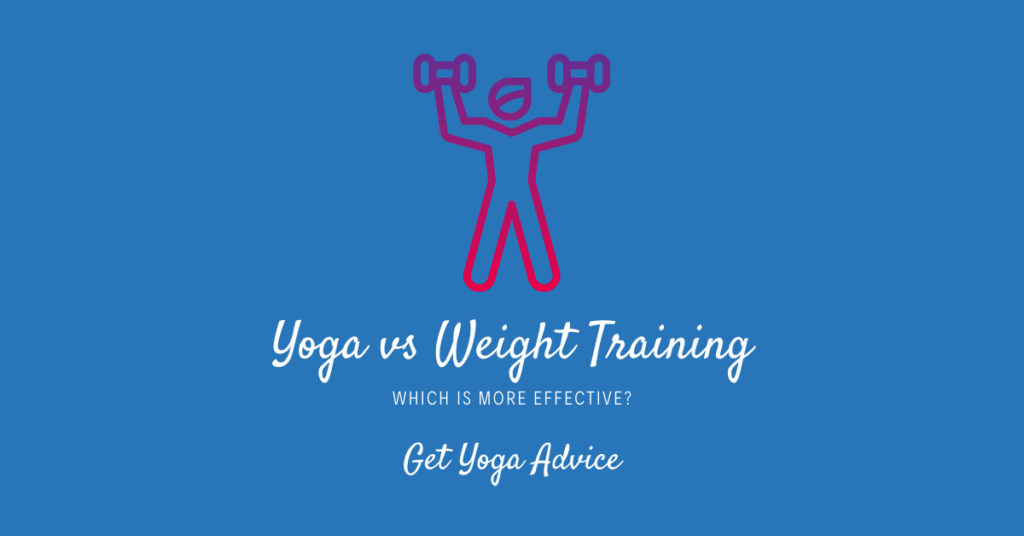If you are looking to compare yoga vs weight training, then you might be wondering which is more effective. The answer is that it depends. What would you like to get out of your weight training or yoga workouts? There are a few points that you should keep in mind.
Contents
An Introduction to Yoga vs Weight Training
Yoga

Yoga has been promoted as a great tool to help you exercise both your mind and body. The well-rounded nature of yoga workouts has been one of its greatest benefits. Some of the benefits of yoga include:
- Yoga focuses on training both your mental health and physical health
- Yoga incorporates various poses that can help you strengthen your core
- Yoga can help you manage issues such as anxiety
- Yoga can help you improve the flexibility of your joints, helping you resist injuries in the future
At the same time, yoga has a few drawbacks as well. Some of the disadvantages of yoga include:
- Trying to perform yoga without the guidance of a trained professional could lead to injuries
- If you practice specialty forms of yoga, such as hot yoga, you could develop dehydration or heat exhaustion
Weight Training

Now, it is time to take a closer look at weight training. While weight training is the most direct way to add muscle mass, there are a few additional benefits as well. These include:
- Weight training can increase your metabolism, burning fat
- Weight training can increase your body’s sensitivity to insulin, reducing your risk of developing diabetes
- Weight training can provide you with more energy and mental clarity
- Weight training can improve your bone density, reducing the risk of bone fractures and osteoporosis
There are a few drawbacks to weight training as well. These include:
- If children start lifting weights at too young of an age, this could stunt their growth
- Proper weight training requires specialized equipment, which might be expensive, as well as specialized instruction, which prevents injuries
With an overview of both topics, it is time to explore them in detail.
You might find our weight lifting for running guide helpful.
The Benefits of Yoga
Yoga has been described as a lifestyle just as much as it is a workout routine. The goal of yoga is to take a holistic approach to your overall health and wellness. In this manner, some of the main benefits of yoga include:
- Flexibility: Holding yoga’s various poses will help you lengthen your muscle fibers and increase the flexibility of your ligaments. As you perform yoga, you will find that you can go deeper into each pose under the guidance of an instructor. This is a sign that your flexibility is increasing.
- Pain management: If you suffer from chronic pain, the last thing you might want to do is exercise. Yoga can actually help you manage your chronic pain by strengthening vulnerable areas of your body while also improving your mental clarity.
- Injury prevention: In addition to its mental health benefits, yoga can also help you prevent injuries. When you increase your flexibility, your joints are better able to resist the stresses of athletic activity. This helps you prevent injuries from taking place.

At the same time, you have to be careful while performing yoga. While you don’t need anything to do yoga aside from proper workout clothing and a mat, you should have the guidance of an instructor. This can help you avoid a few key drawbacks, including:
- Trying to perform advanced poses without the right experience could lead to injuries
- Performing hot yoga or cardio yoga could lead to dehydration and heat exhaustion
If you are looking for a workout routine that focuses on injury prevention, coordination, and mental health, then yoga might be for you.
The Benefits of Weight Training
Weight training has been one of the primary components of numerous athletic teams fitness programmes. While this is one of the most popular ways to bulk up, some of the main benefits of weight training include:
- Bone mass: Resistance training, including weight training, can help you increase your bone mass. By increasing bone density, you can prevent bone fractures and osteoporosis.
- Diabetes prevention: Weight training can also help you prevent diabetes by increasing your sensitivity to insulin.
- Body composition: While weight training itself might not lead to weight loss, it can help you burn fat and increase muscle mass. In this manner, weight training can improve your body composition.

It is critical to lift weights safely. This means relying on the guidance of trained professionals, particularly when first learning how to lift weights. The drawbacks include:
- Weight training in young children could prematurely close their growth plates, leading to stunted growth
- Weight training could lead to serious injuries if not done properly
- Weight training is great for athletes looking to put on muscle mass as well as individuals looking to prevent diabetes and osteoporosis.
The Final Word on Yoga vs Weight Training
When it comes to yoga vs weight training for weight loss, disease prevention, mental health issues, and more, both can be effective options. Yoga is better for a well-rounded approach to health and wellness. Weight training can help you bulk up for sports while also preventing chronic medical conditions such as diabetes and osteoporosis.



